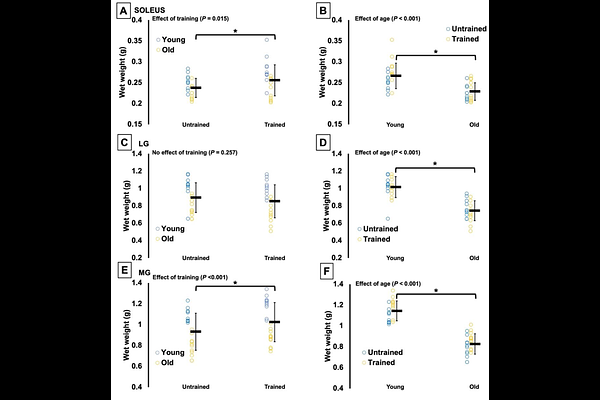Age-related blunting of serial sarcomerogenesis and mechanical adaptations following 2 weeks of maximal eccentric resistance training

Age-related blunting of serial sarcomerogenesis and mechanical adaptations following 2 weeks of maximal eccentric resistance training
Hinks, A.; Patterson, M. A.; Njai, B. S.; Power, G. A.
AbstractBackground: During natural aging, muscles atrophy, which is partly accounted for by a loss of sarcomeres in series. Serial sarcomere number (SSN) is associated with aspects of muscle mechanical function including the force length and force velocity power relationships; hence, the age-related loss of SSN contributes to declining performance. Training emphasizing muscle lengthening (eccentric) contractions increases SSN in young healthy rodents. However, the ability for eccentric training to increase SSN and improve mechanical function in old age is unknown. Methods: Ten young (9 months) and 11 old (33 months) Fisher344/BN F1 rats completed 4 weeks of unilateral isokinetic eccentric plantar flexion training 3 days/week. Pre and post training, the plantar flexors were assessed for maximum tetanic torque (ankle angles of 70deg and 90deg), the torque-frequency relationship (stimulation frequencies of 1 to 100 Hz), the passive torque-angle relationship (ankle angles of 110 to 70 deg), and the torque angular velocity power relationship (isotonic loads of 10% to 80% maximum). Following post training testing, rats were sacrificed, and the soleus, lateral gastrocnemius (LG), and medial gastrocnemius (MG) were harvested for SSN assessment by measuring sarcomere lengths with laser diffraction, with the untrained leg used as a control. Results: In the untrained leg/pre-training, old rats had lower SSN in the soleus (9%), LG (7%), and MG (14%), lower maximum torque (27 to 42%), power (63%), and shortening velocity (35%), and greater passive torque (62 to 191%) than young. Young rats showed increased SSN from the untrained to the trained soleus and MG. In contrast, old rats had no change in soleus SSN between legs and experienced SSN loss in the LG. Pre- to post-training, young rats saw modest improvements in isometric mechanical function, including a 13% increase in maximum torque at 90 deg and 4 to 11% increases in 10-60 Hz torque. Old rats, however, had reductions in maximum torque (35%), shortening velocity (46%), and power (63%), and increased passive torque (24 to 51%) from pre- to post-training. Conclusions: Eccentric training induced serial sarcomerogenesis and improved mechanical function in young rats, while old rats exhibited dysfunctional remodeling that led to impairments in muscle mechanical performance following training.